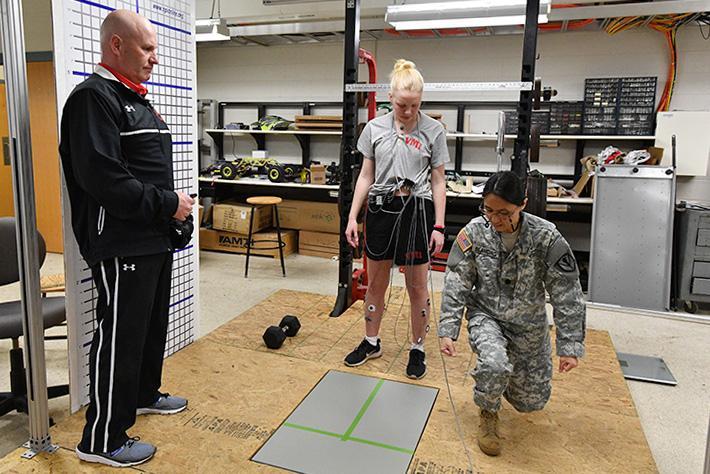Study Explores Functional Movement

Col. Mike Krackow and Lt. Col. Joyce Blandino show Jamie Foster ’20 how to lunge onto the force plate to measure muscular electrical impulses in Nichols Engineering Building.—VMI Photo by Kelly Nye.
LEXINGTON, Va., March 22, 2018—Research currently underway in VMI’s biomechanics laboratory could someday be used as part of a program designed to prevent falls among the elderly.
This academic year, Lt. Col. Joyce Blandino, associate professor of mechanical engineering, and Col. Mike Krackow, professor of physical education, are working together to study how people use their bodies when confronted with asymmetrical loading—a situation in which they are carrying much more weight on one side of their body than the other.
Krackow explained that he and Blandino decided to investigate asymmetrical loading because there’s not much research on it—and because it’s a common part of real life, as people develop patterns of movement that can include carrying a purse or bag only on one side of their bodies.
“Everything now is functional training, functional movements,” said Krackow, noting that focusing on functional movement in the lab has greater real-world application.
To test this, subjects are hooked up to eight electromyography sensors on their legs and hips, which record the electrical activity used by muscles, plus an additional sensor on the upper chest, which records any lateral sway of the body. They then give them dumbbells of varying weights to hold as they step onto a force plate, which measures the force exerted. Lastly, the subjects are asked to do the same test as they hold only one dumbbell.
“If we go asymmetrical with one dumbbell, we should either see more sway and/or increased muscle activity on the opposite side,” said Krackow, who has a background in physical therapy and athletic training.
Ultimately, Krackow explained, the data they are collecting could be used to develop programs, perhaps implemented by health care providers, that would increase the efficiency and safety of movement.
“As people age, how does the body change?” asked Blandino. “How can you train your body to reduce the prospect of falling?”
Both Blandino and Krackow are excited to be working on a project that could someday reach well beyond the Institute.
“Out of the three [studies] we’ve done, this one has the most potential for direct application well beyond VMI,” said Krackow. “Everything we do, we try to disseminate beyond VMI.”
The researchers are keenly aware that with more equipment, they could do more. Funding for the equipment currently in use was provided by a Jackson-Hope grant approximately three years ago. Now, they’d like to apply for a major research instrumentation grant from the National Science Foundation.
“We need more equipment to do more study,” said Blandino. “Right now, it’s really limited to one foot. With two force plates, [subjects] could run. They could jump.”
She added that with more equipment, including a sophisticated camera system, they could also study joints such as the knee and ankle in isolation.
For now, Blandino and Krackow’s study is ongoing—and they are seeking more subjects of all ages and both genders. Subjects do not have to come from the VMI community.
Said Krackow, “All data is good data.”
- Mary Price
-VMI-
.svg)
.png)